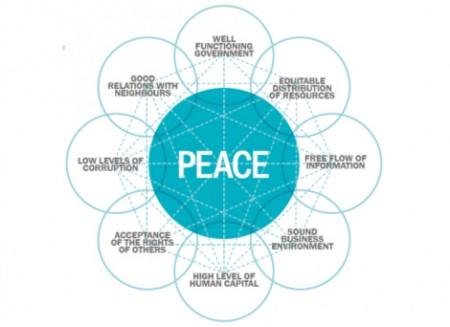
One of the major challenges facing the peacebuilding and development community today is how to balance short term humanitarian assistance with long term efforts to build capacity and resilience. We see this tension played out in many countries receiving significant overseas development assistance (ODA). Part of the problem is a lack of reliable data which, in turn, affects our ability to understand the effectiveness of the resources that international donors have channeled into peacebuilding efforts. This does not imply that these efforts are failing, but rather that we don’t know enough about their impact and the extent to which they are making progress towards building long-term capacity and resilience.
To help monitor and evaluate the long term progress of countries, the Institute for Economics and Peace (IEP) has developed a framework that analyzes data and attitudinal surveys in conjunction with current thinking about the long term drivers of peace, resilience and conflict. Recently launched in Geneva, the Pillars of Peace report identifies the attitudes and structures that typically underpin peaceful societies. The report shows that countries which tend to be more peaceful have a number of characteristics in common. For instance, peaceful countries are more equitable, have lower levels of corruption and higher levels of human capital. This shows that development assistance needs to look beyond short term efforts to contain violence and instead focus on the slow moving but underlying ‘Pillars’ that support peaceful societies.
While formal institutions inevitably play an important role in improving public service delivery and ensuring better governance, the Pillars of Peace also emphasize the role that informal norms, behaviors and attitudes play in building peaceful societies. For instance, countries with greater levels of interpersonal trust – as measured by attitudinal surveys such as Gallup World Poll and World Values Survey – tend to be more resilient and less prone to conflict. Countries with stronger social capital and more flexible social ties also respond more effectively to sudden shocks which can spark conflict, such as natural disasters or sudden changes in food prices.
Countries with weaker Pillars also tend to have made little progress in attaining the Millennium Development Goals (MDGs). This, in turn, underlines the role that institutions not only play in preventing conflict, but also in driving the conditions for other key development gains and resilience against future shocks. Indeed, this mirrors findings presented by the World Bank in its 2011 World Development Report, which found few conflict-affected states had achieved their MDGs and that conflict can quickly destroy many of the institutions that support peace.
One of the most striking findings from the research is that the strength of a country’s Pillars provides indicators as to how peaceful nations might be in the future. That is, countries with stronger Pillars in previous years tend to be those which have experienced the longest cycles of peace in later years. As an illustration, countries with higher levels of land inequality as measured by the Food and Agriculture Organization of the UN (FAO) in 1980 have, on average, experienced the highest declines in peace as measured by the Global Peace Index. This does not imply that land inequality is a ‘silver bullet’ for preventing conflict, but is instead one of the many Pillars that sustains peace.
While it may be tempting to derive universal templates for how nations can build the Pillars of Peace, this approach instead strives for a better understanding of how unique informal and formal institutions operate in different contexts. Similarly, this does not attempt to identify direct causality but rather emphasize that causality is dependent on the very unique geographic, historic and material circumstances of different countries. While common characteristics may underlie more peaceful nations, how long-term institutional capacity is developed over time is strongly reliant on a deep understanding of the local context. That’s why it is important to see the Pillars uniquely in each and every different national context.
The threat of external shocks and conflict in rolling back hard-won development gains underpins the importance of measuring the progress of institutions in order to better understand whether countries are progressing towards peace. Such measurement exercises are not about deriving a measure for the sake of it, but about trying to provide a practical framework and guideposts to support wider peacebuilding efforts. By doing so we may help increase accountability, improve advocacy, encourage resilience-building and ultimately assist long term development.
Daniel Hyslop is Research Manager at the Institute for Economics and Peace (IEP).
For additional reading on this topic please see:
Post-2015: Framing a New Approach to Sustainable Development
A Guide for Planning and Strategy Development in the Face of Complexity
Development Success: Historical Accounts from More Advanced Countries
For more information on issues and events that shape our world please visit the ISN’s Weekly Dossiers and Security Watch.

